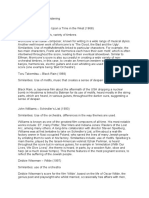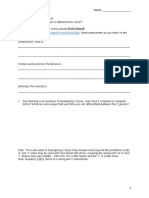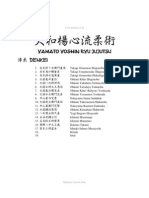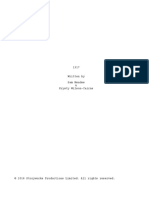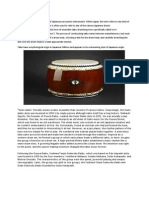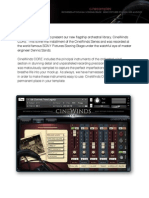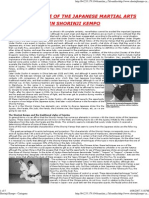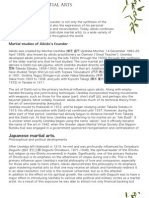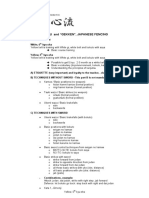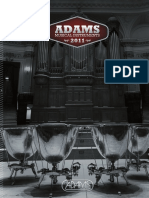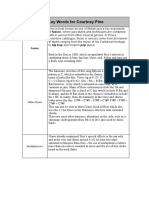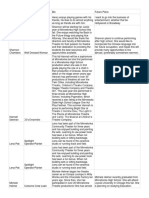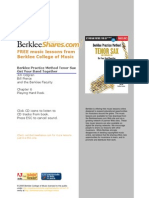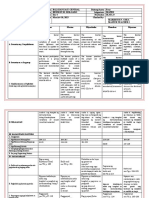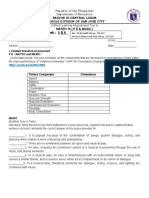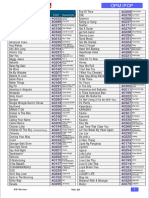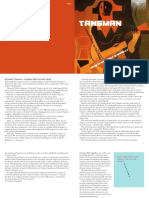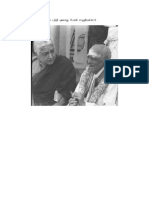Bernard Herman (1911-1975) - An American Comp Composer and Conductor Who
Bernard Herman (1911-1975) - An American Comp Composer and Conductor Who
Uploaded by
Woodface1Copyright:
Available Formats
Bernard Herman (1911-1975) - An American Comp Composer and Conductor Who
Bernard Herman (1911-1975) - An American Comp Composer and Conductor Who
Uploaded by
Woodface1Original Description:
Original Title
Copyright
Available Formats
Share this document
Did you find this document useful?
Is this content inappropriate?
Copyright:
Available Formats
Bernard Herman (1911-1975) - An American Comp Composer and Conductor Who
Bernard Herman (1911-1975) - An American Comp Composer and Conductor Who
Uploaded by
Woodface1Copyright:
Available Formats
Keywords Psycho
Bernard Herman (1911-1975) - An American comp composer and conductor who
specialised in film music. His best-known work, apart from Psycho, includes the
scores for Orson Welles’ classic Citizen Kane (1941) and Taxi Driver (1976). He won
an Oscar for his score for The Devil and Daniel Webster (1941). Hermann is
particularly associated with the films of Alfred Hitchcock, with whom he collaborated
on 7 films between 1956 and 1966; the best-known of these are Psycho (1960),
North by Northwest (1959) and Vertigo (1958). He had a comprehensive knowledge
of 20th Century musical styles and used this in his own music (Psycho shows
influences of Debussy, Bartok and Stravinsky). His music often features ostinato
patterns and unstable, dissonant chords.
Psycho - a low budget black and white film (unusual in 1960), the 6 th collaboration
between Hermann and Hitchcock, who always acknowledged Hermann’s importance
to its success. Hermann matches Hitchcock’s cold black and white world by creating
what he called ‘black and white music’, using only the string section of the orchestra
and with a dissonant and sometimes atonal style. This use of only a conventional
orchestral string section (Violins 1 and 2, Violas, Cellos, Double Basses) is a radical
departure from conventional film music scores and creates a claustrophobic and
closed-in sound world. It forces him to be very creative in his use of texture and
timbre. His music also makes use of ostinato patterns and Leitmotifs.
Rhythm, Tempo and Metre
Adagio e mestro - Tempo mark indicating slowly and sadly. Heard in the Finale, it
helps to portray the sombre ending to the film; the extent of the killer’s crimes are
finally revealed.
Allegro feroce - Tempo mark indicating fast and ferocious. Heard in Discovery, the
marking reflects the horror and violence of these cues.
Allegro molto agitato - Tempo mark indicating fast and very agitated. Heard in
Prelude, it forebodes the horrors of cues/scenes to come.
Lento assai – Tempo marking indicating very slow. Heard in Marion, this slow,
funeral-esque tempo marking foreshadows the doomed ending of our protagonist.
Lento molto sostenuto – Tempo mark indicating very slow and very sustained. Heard
in The City, again suggests an impending sense of doom.
Molto forzando e feroce – Tempo mark indicating very forced and ferocious. Heard in
The Murder, the marking reflects the horror and violence of these cues.
Cross-rhythm – 2 or more different rhythmic patterns occurring simultaneously and
appearing to work ‘against’ each other. Heard in Discovery (b. 19-25), it depicts the
the horror of what is found.
Moto perpetuo – Italian term meaning a musical device of constantly running
quavers or semiquavers, creating a sense of perpetual movement. Heard in the
Cellar as contrapuntal ideas combine, building up the tension.
Polyrhythm – 2 or more rhythmic patterns happening at the same time. Heard in
Discovery (b.19-25), it depicts the horror of what is found.
Rhythmic augmentation – Elongating the note values of a phrase or motif, heard in
the upper strings in The Toys, which is related to the ‘Marion’ rhythm.
Instrumentation:
Arco – Playing an orchestral stringed instrument with the bow. Heard in Prelude, The
City, Marion, The Murder (from bar 17), Toys, The Cellar, Discovery. Hermann uses
the full range of string playing techniques, which creates a colourful palette of
timbres throughout the cues. Arco playing is more sustained, emphasising
dissonance in cues such as The Cellar and Discovery and helping to provide a
mournful tone to melodies in cues such as Marion. Arco is also the predominant style
of play in Young’s ‘The Grudge’ and Barry’s ‘King Kong’ (for example, ‘Maybe My
Luck Has Changed’).
Con sordino – Instruction to instrumental player to play with mute. Heard in all cues
except The Murder. This playing technique sounds repressive and creates a sense
of claustrophobia. This could be linked to Marion’s character, a woman trapped and
doomed to die at the hands of Bates. Also used in Debussy’s ‘Prelude a l’apres-midi
d’un Faun’.
Divisi – instruction to string players when 2 notes are written on the score to divide
the notes between them. Heard in Prelude (bars 126-130), The City, The Toys and
The Cellar. Creates a fuller texture and adds to the sense of horror in the darker
cues.
Double stopping – String players playing more than 1 note at the same time. An
extended technique, which creates a fuller texture and adds to the sense of
claustrophobia in the darker cues.
Pizzicato – Instruction to orchestral string players to pluck the string, rather than play
with the bow. Heard in The Murder and The Toys. The staccato, ‘stabbing’ plucks of
the string reflect the sudden violent moments in the darker cues of the film. Also
heard in Debussy’s Prelude a l’apres-midi d’un Faune’.
Senza sordini – Instruction to play without a mute. This can be heard in The Murder
and is the only cue where mutes are removed. This makes the aggressive violence
in the music even more effective.
Sffz – Dynamic/expression marking meaning a sudden, very strong accent.
Sometimes written as ‘sfz’. As heard in The Murder, this makes the aggressive
violence in the music even more effective.
Sul ponticello – Instruction to string players to play near the bridge, altering the
timbre, as it doesn’t allow the string to vibrate enough to achieve the usual warmth of
tone. It can sound metallic or more eerie. Heard in The Cellar (b. 47-61). Adds
suspense and tension to the scene.
Tremolo – String technique meaning the rapid repetition of a single note produced by
a quick back-and-forth movement of the bow or the rapid reiteration of two notes
(fingered tremolo). Heard in Prelude and The Cellar (b.1-2). There are also markings
for senza tremolando (meaning without tremolando) in The Cellar. These markings
emphasise the suspense and tension in this scene. Jarre also uses this technique to
create tension in ‘Lawrence of Arabia’.
Structure
Underscore – Music that plays in the background of a film score. For example, the
opening 3 bars of The City is repeated in various guises 6 times in the film. Mostly
associated with characters in mundane situations.
Cue – Each separate piece of music in a film score. Cues can also provide links from
one scene to another. For example, the ‘stabbing’ chords in The Murder are used 4
other times in the film, associated with the murder or consequences of the murder.
Tonality
Atonality – Music that lacks a sense of key or tonal centre. Heard in The Murder,
Discovery, atonality emphasises the horror of the scenes. Also, heard in Finale,
reflecting the total fragmentation of Bates’ descent into madness. Goldsmith’s ‘The
Omen’, along with many other horror film scores contain atonal cues.
Harmony
Chromaticism – The use of notes outside the key, or designed to destabilise the
key/tonal centre. Heard in Prelude (use of extension chords in b. 21), The Toys, The
Cellar, Discovery and Finale. Adds a sense of darkness and horror to the cues.
Chromaticism is also heavily used in Bartok’s String Quartet No 1, Mv 1.
Cluster chord – A chord made up of dissonant, closely spaced notes. Heard
throughout The Murder cue the final chord of The Cellar (Db augmented triad, with C
sharp dim chord). Adds a sense of darkness and horror to the cues. Williams uses
cluster chords during the opening battle scene for ‘Star Wars’.
Diminished 7th chord – a chord made up of 3 minor 3 rd intervals on top of each other,
The intervals are the same in each inversion of the chord. Heard in Prelude and
throughout other cues. Adds a sense of darkness and horror to the cues. Jarre also
makes frequent use of this type of chord in ‘Lawrence of Arabia’.
Dissonance – Notes of harmonies that clash, creating an ‘ugly’ sound. Used to
create musical interest and tension throughout all of the cues. Dissonance can also
be heard throughout Young’s ‘The Grudge’, Goldsmith’s ‘The Omen’, Barry’s ‘King
Kong’ and Pledouris’ ‘The Hunt for Red October’, again to create an uncomfortable
atmosphere.
Half-diminished chord – A diminished chord (root, flat 3 rd, flat 5th) to which a flattened
7th is added. Heard in b1.4 of The City. Adds a sense of darkness and horror to the
cues.
‘Hitchcock’ chord – The opening chord in ‘Prelude’. It consists of a minor chord with
added major 7th (Bb, Db, F, A), creating an unstable sound at the start. It is used
throughout this cue. Also heard at the end of ‘Marion’ (b. 17). Use of the Hitchcock
chord can also be heard in Hermann’s ‘Vertigo’.
Non-functional harmony – Chords or chord progressions that do not serve to
establish a key or move the music towards the tonic but are employed for their sound
or colour. Heard throughout the cues – one example being chains of parallel major
and minor 7th chords moving by step, heard in The Toys. Non-functional harmony is
typically used in horror genre, for example in Goldsmith’s ‘The Omen’.
Texture
Fugal – Contrapuntal texture sharing some of the characteristics of a full fugue but
not all. For example, heard in The Cellar from bar 5. Creates a sense of confusion,
as Lila escapes from Bates. The use of subjects/countersubjects and fugues link to
the music of the Baroque era.
Fugal subject – Theme that starts a fugue or fugal passage in a piece; it is the
material that forms the basis for the melody throughout the section. For example,
heard in The Cellar from bar 5. Creates a sense of confusion, as Lila escapes from
Bates. The use of subjects/countersubjects and fugues link to the music of the
Baroque era.
Ostinato – Short recurring musical pattern. For example, heard in the quaver figure
from b. 3 of Prelude. Creates an obsessive atmosphere. Use of ostinato is typical of
film music writing and can also be heard Williams’ ‘Star Wars’.
Pedal note – A long held (or repeated) note, usually in the bass, over which the
harmonies change. If the pedal note is repeated, rather than sustained, it can be
referred to as an articulated pedal. A pedal note at the top of the texture is referred to
as an inverted pedal. As heard in the lower string parts of The Toys. A typical feature
of film music, pedals often portray a sense of the foreboding and can also underpin
the tonality. Young makes frequent use of pedals in his score for ‘The Grudge’, as
does Barry in ‘King Kong’ (in particular ‘The Opening’) to similar effect.
Melody
Anacrusis – beginning a melody on an upbeat. Heard in the opening of Marion,
which emphasises the ‘sighing’ 3 note melody, suggesting a character doomed to
die. Anacrusis’ are often used in films, an example could be found in the opening
melody of ‘Now We Are Free’ from Zimmer’s ‘Gladiator’.
Countersubject - 2nd melodic phrase in a fugal passage, played by the 1 st part it has
completed the subject. The use of subjects/countersubjects and fugues link to the
music of the Baroque era.
Leitmotif - A short musical phrase associated with a person, place or idea. First used
by Wagner. As heard Finale, in the 3-note motif introduced at b. 15 by the solo viola.
Called the ‘Madness Leitmotif’. The use of Leitmotifs is typical in film music writing,
for example Williams’ Luke Skywalker Leitmotif in ‘Star Wars’, and Elfman’s Batman,
Catwoman and The Penguin Leitmotifs in ‘Batman’.
Melodic inversion - Playing a melody with the intervals turned upside down (e.g.
when the original melody goes up a 3rd, the inverted version goes down a 3rd). This
develops the melody and adds more variety to the music.
Motif - Short melodic cell that can be developed or combined to create longer
melodies or left on their own. An example can be found in bars 26 – 36 of Discovery.
’The Opening’ from Barry’s ‘King Kong’, Hermann’s ‘Vertigo’ and Debussy’s ‘Prelude
a l’apres-midi d’un Faune’ also contain short, motivic material.
Retrograde - Playing a melody backwards. Can be heard in in bars 2-3 and 4-5 of
The Cellar. Adds variety to the melodic content whilst still sounding familiar. This
links to the 5th movement of Stravinsky’s ‘Canticum Sacrum’, with the melody being a
retrograde of the 1st movement’s melody.
Subject - Opening idea in a fugue or fugal section. There is an 8 bar subject in the
fugal passage of The Cellar. The use of subjects and fugues link to the Baroque era.
Transpose - Change a melody to a different key, raising or lowering the pitch. It can
be written with or without a key change. For example in Discovery, (b. 26, 28, 30, 32,
34) the highest notes of the chromatic scales spell out the first 5 notes of the Psycho
theme, transposed. The use of transposition links Hermann’s main thematic material
throughout the cues. The use of transposition is typical in music for film, for example
Elfman’s main thematic material is transposed in various cues in his score for
Batman.
Verticalisation - When the notes of a melody or motif are played as a chord (i.e.
‘vertically’). Can be heard in the F-E pedal in The Toys, which builds on the semitone
motif in the Prelude. The use of verticalisation links Hermann’s main thematic
material throughout the cues.
Dynamics – Hermann covers a full range of dynamics from ‘ppp’ in The Toys to
unmuted ‘sffz’ at the opening of The Murder. The range of dynamics reflect the
events taking place in each cue. William’s also uses a broad range of dynamics in
his film scores, for example ‘Star Wars’.
You might also like
- Violin Excerpts Clean Practice Parts 6th EdDocument254 pagesViolin Excerpts Clean Practice Parts 6th Edkengraves2000No ratings yet
- Elfman Batman Wider ListeningDocument5 pagesElfman Batman Wider ListeningWoodface150% (2)
- 143 Chord Progressions To Learn or KnowDocument9 pages143 Chord Progressions To Learn or KnowPenuel85% (13)
- Toyama Nakamura Ryu Shinkendo Obata ToshishiroDocument2 pagesToyama Nakamura Ryu Shinkendo Obata ToshishiroReza MiyamotoNo ratings yet
- The Kyogen BookDocument3 pagesThe Kyogen BookRicardo Da Silva MachadoNo ratings yet
- Guangdong Yinyue MEP Music NotesDocument4 pagesGuangdong Yinyue MEP Music NotesThomas RettigNo ratings yet
- Yamato Yoshin RyuDocument1 pageYamato Yoshin RyuPetar RasetaNo ratings yet
- Ma Sicong AnalysisDocument66 pagesMa Sicong AnalysisyanososmimargaritaNo ratings yet
- Rite of Spring WorksheetDocument4 pagesRite of Spring WorksheetBenjamin BuchananNo ratings yet
- Vivaldiâ ™s Four Seasons (Spring)Document8 pagesVivaldiâ ™s Four Seasons (Spring)Karen Angela DanaoNo ratings yet
- Kevin Cadogan Interview in Guitar Player MagazineDocument3 pagesKevin Cadogan Interview in Guitar Player Magazineohnevermindme94No ratings yet
- Ellington, Duke in Oxford Music OnlineDocument7 pagesEllington, Duke in Oxford Music OnlineMarcio GarciaNo ratings yet
- Sar Oumad Zemestoun v01b Music Score سر اومد زمستون، نت موسیقیDocument1 pageSar Oumad Zemestoun v01b Music Score سر اومد زمستون، نت موسیقیPayman Akhlaghi (پیمان اخلاقی)100% (3)
- 17 2Document10 pages17 2Godwin Ariwodo75% (8)
- Hunter X Hunter - Ohayou TabsDocument3 pagesHunter X Hunter - Ohayou TabsJan Lawrence AlbertoNo ratings yet
- Takemitsu Essay DragonDocument5 pagesTakemitsu Essay DragonMewdicalNo ratings yet
- Worksheet - Strings of The ViolinDocument1 pageWorksheet - Strings of The ViolinBeatriz AlcaldeNo ratings yet
- 2010 Japanese Traditional Music EnglishDocument33 pages2010 Japanese Traditional Music EnglishNabin BajracharyaNo ratings yet
- Koizumi TetrachordDocument198 pagesKoizumi TetrachordRomullo QueirozNo ratings yet
- TaikopedroDocument15 pagesTaikopedroapi-341712673No ratings yet
- 00 - Ensemble Yonin No Kaï - Ocora Japon, Sankyoku, Ensemble Yonin No KaïDocument1 page00 - Ensemble Yonin No Kaï - Ocora Japon, Sankyoku, Ensemble Yonin No KaïRoberto MacielNo ratings yet
- 1917Document120 pages1917MarcNo ratings yet
- REGAN Composing JapanDocument18 pagesREGAN Composing JapanFrancisco Javier González-Velandia GómezNo ratings yet
- EScholarship UC Item 1k1860wxDocument210 pagesEScholarship UC Item 1k1860wxBrandonBedoreNo ratings yet
- Budo and ZenDocument2 pagesBudo and ZenkjhlkjashdflkjashdflNo ratings yet
- Tsugaru Shamisen: Bachi. The Tsugaru Shamisen Is A Kind of ShamisenDocument1 pageTsugaru Shamisen: Bachi. The Tsugaru Shamisen Is A Kind of ShamisenrenewedNo ratings yet
- Sound JapanDocument20 pagesSound JapanRyusuke SaburoNo ratings yet
- Japanese Musical InstrumentsDocument5 pagesJapanese Musical Instrumentsjosiah venice100% (1)
- 127 Threadgillsmithsem2014tenderDocument4 pages127 Threadgillsmithsem2014tenderMma Best SportNo ratings yet
- Guide To ABRSM Grade 1 Aural TestsDocument13 pagesGuide To ABRSM Grade 1 Aural TestsDenise MirandaNo ratings yet
- Hip Hop Culture - History and TrajectoryDocument33 pagesHip Hop Culture - History and TrajectoryVince SardinaNo ratings yet
- Murakami 1988. Incest and Rebirth in KojikiDocument10 pagesMurakami 1988. Incest and Rebirth in KojikiEmiel NachtegaelNo ratings yet
- Bokken Suburi: 01: ICHI NO SUBURI (Shomen Uchi)Document2 pagesBokken Suburi: 01: ICHI NO SUBURI (Shomen Uchi)Mahieddine Mokhtari0% (1)
- Taiko JoyDocument2 pagesTaiko JoySi OneilNo ratings yet
- PERCUSSIONDocument15 pagesPERCUSSIONTon RJ Ido0% (1)
- Clarinet Repertorie Bullet Example (Chanul Kim)Document8 pagesClarinet Repertorie Bullet Example (Chanul Kim)Chanul KimNo ratings yet
- CineWinds Core ManualDocument9 pagesCineWinds Core ManualWally Scharold100% (1)
- Japanese Ma Influence Onshor in JDocument5 pagesJapanese Ma Influence Onshor in JBodibodiNo ratings yet
- Schuck (1943) Observations On The Vibrations of Piano StringsDocument11 pagesSchuck (1943) Observations On The Vibrations of Piano StringsFederico BejaranoNo ratings yet
- Intonation On A String Instrument: Three Systems of Tuning and TemperamentDocument4 pagesIntonation On A String Instrument: Three Systems of Tuning and TemperamentnanoNo ratings yet
- P Glossary PDFDocument25 pagesP Glossary PDFScott RennerNo ratings yet
- Also Sprach ZarathustraDocument3 pagesAlso Sprach ZarathustraTom Mizani100% (1)
- Aikido Curriculum Core Techniques KidsDocument113 pagesAikido Curriculum Core Techniques KidslaukuneNo ratings yet
- Lesson SevenDocument6 pagesLesson SevenMnemonic TanzNo ratings yet
- Peter and The Wolf - Family Resource Pack Draft 4Document29 pagesPeter and The Wolf - Family Resource Pack Draft 4Lúcia LealNo ratings yet
- Listening To Indian Classical MusicDocument6 pagesListening To Indian Classical MusicBhairava Sanjay NathaNo ratings yet
- Glazunov: Violin Concerto in A Minor, Op 82 Meditation, Op 32 Mazurka-Oberek (1917)Document17 pagesGlazunov: Violin Concerto in A Minor, Op 82 Meditation, Op 32 Mazurka-Oberek (1917)sadabrj100% (2)
- Toronto Symphony OrchestraDocument3 pagesToronto Symphony OrchestraErin MaughanNo ratings yet
- Batto Jutsu Practice Sheet - Dothan Dojo - Dec 2012Document7 pagesBatto Jutsu Practice Sheet - Dothan Dojo - Dec 2012Frederic LecutNo ratings yet
- Bali Colin McpheeDocument7 pagesBali Colin Mcpheedanielll17No ratings yet
- Instrument Written Sounding Notes: Timpani PagesDocument3 pagesInstrument Written Sounding Notes: Timpani PagesGiorgio PlanesioNo ratings yet
- Thesis FulltextDocument340 pagesThesis Fulltextcuradarsjr100% (1)
- Ethel Smyth Composer:suffragetteDocument8 pagesEthel Smyth Composer:suffragetteGillian DererNo ratings yet
- History PagesDocument53 pagesHistory Pagessoulboy01100% (1)
- China Musical InstrumentsDocument33 pagesChina Musical InstrumentsKimberley Yapp KY100% (1)
- MMus APP7 - Thoughts On PerformanceDocument4 pagesMMus APP7 - Thoughts On PerformanceAntonio LoscialeNo ratings yet
- Koden Enshin Ryu YellowDocument1 pageKoden Enshin Ryu YellowFredrik MarkgrenNo ratings yet
- Adams 2011Document19 pagesAdams 2011raihanNo ratings yet
- The Shakuhachibynorman Allen StanfieldDocument274 pagesThe Shakuhachibynorman Allen StanfieldFabNo ratings yet
- Aikido Kids Guide 0Document9 pagesAikido Kids Guide 0Mark RamyNo ratings yet
- Eduqas 05 Texture Timbre and Dynamics AnswersDocument18 pagesEduqas 05 Texture Timbre and Dynamics AnswersMolly NewtonNo ratings yet
- Traditional Chinese Musical InstrumentsDocument18 pagesTraditional Chinese Musical InstrumentsNgina GacheruNo ratings yet
- The Elements of 20th Century MusicDocument2 pagesThe Elements of 20th Century Musicapi-287736239No ratings yet
- How to Play Suona, the Chinese Double-reed Horn: The Basic Skills: How to Play Suona, the Chinese Double-reed Horn, #1From EverandHow to Play Suona, the Chinese Double-reed Horn: The Basic Skills: How to Play Suona, the Chinese Double-reed Horn, #1No ratings yet
- Graceland Analysis SheetsDocument10 pagesGraceland Analysis SheetsWoodface1No ratings yet
- Intro To EducasDocument15 pagesIntro To EducasWoodface1No ratings yet
- Rhythm Metre and Tempo Key WordsDocument2 pagesRhythm Metre and Tempo Key WordsWoodface1No ratings yet
- Mozart Key WordsDocument6 pagesMozart Key WordsWoodface1No ratings yet
- Purcell Music For A WhileDocument2 pagesPurcell Music For A WhileWoodface10% (1)
- Courtney Pine Key WordsDocument9 pagesCourtney Pine Key WordsWoodface1No ratings yet
- La Vita È Bella DrumsDocument2 pagesLa Vita È Bella DrumsFabrizio BrezzoNo ratings yet
- The Beatles With A Little Help From My Friends LyricsDocument23 pagesThe Beatles With A Little Help From My Friends Lyricswf34No ratings yet
- Rossetti Cosimo YaoDocument5 pagesRossetti Cosimo YaoXNo ratings yet
- Bright Star BiosDocument9 pagesBright Star BiosJoseph FerrieroNo ratings yet
- Mapeh PTDocument5 pagesMapeh PTCrissa BuenavistaNo ratings yet
- Berklee Basic Hard Rock Tenor SaxDocument8 pagesBerklee Basic Hard Rock Tenor SaxgrangorgeNo ratings yet
- Panalangin ChordsDocument4 pagesPanalangin ChordsKarla Mae ReodiqueNo ratings yet
- Big Band Seating Arrangement - Set UpDocument2 pagesBig Band Seating Arrangement - Set UpOrnette McColemanNo ratings yet
- Ed Sheeran GenreDocument22 pagesEd Sheeran GenreDee Watson0% (4)
- Classical To ContemptDocument16 pagesClassical To ContemptMichi AmamiNo ratings yet
- Los Dos Amigos - James Swearingen G1,5 FlexDocument37 pagesLos Dos Amigos - James Swearingen G1,5 FlexInês CoelhoNo ratings yet
- Jurnal PianoDocument16 pagesJurnal PianoParas CristinNo ratings yet
- PandangguhanDocument4 pagesPandangguhanAli EresNo ratings yet
- Blackpink LyricsDocument18 pagesBlackpink LyricsHanifah DeeNo ratings yet
- Tocatta and Fugue in D Minor TrumpetDocument4 pagesTocatta and Fugue in D Minor Trumpetwong chen yik0% (1)
- Συμβολα παρτιτούρας PDFDocument1 pageΣυμβολα παρτιτούρας PDFDimos VlahosNo ratings yet
- YUNIT 3 WK 4 MapehDocument5 pagesYUNIT 3 WK 4 MapehBermon HolgadoNo ratings yet
- Johann Sebastian BachDocument21 pagesJohann Sebastian BachEdward MirandaNo ratings yet
- Ulat Pe Music10 Q4 W5 W6Document3 pagesUlat Pe Music10 Q4 W5 W6Rosa Mia MarzanNo ratings yet
- 1 Regulations 7th LISBON INTERNATIONAL CLARINET COMPETITION 1Document4 pages1 Regulations 7th LISBON INTERNATIONAL CLARINET COMPETITION 1Vivian PalominoNo ratings yet
- Gurdjieff and de Hartmann S Music For MoDocument30 pagesGurdjieff and de Hartmann S Music For MoLokitaNo ratings yet
- KS-100 Minibox and KS-10 Mini SD Vol 25 Additional List PP 1-2 OnlyDocument2 pagesKS-100 Minibox and KS-10 Mini SD Vol 25 Additional List PP 1-2 OnlybarrytoleroNo ratings yet
- Music of ChinaDocument18 pagesMusic of ChinaSharmaine Castillo MendozaNo ratings yet
- EVAO MADRID JUNE 4 KEY 2023 Soluciones Inglés - MartesDocument3 pagesEVAO MADRID JUNE 4 KEY 2023 Soluciones Inglés - MartesChristina Miren BovillNo ratings yet
- TANSMAN-Booklet-01 PDFDocument4 pagesTANSMAN-Booklet-01 PDFCristianoPoliCappelliNo ratings yet
- Papanasam SivanDocument28 pagesPapanasam Sivanakileshaiyer100% (1)

